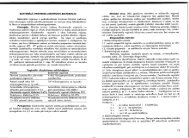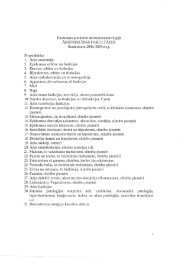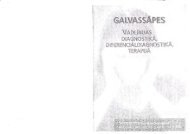PHYSICS
n - susliks.lv
n - susliks.lv
- No tags were found...
Create successful ePaper yourself
Turn your PDF publications into a flip-book with our unique Google optimized e-Paper software.
its bathing medium), there will be very little difference in amplitude<br />
between the light which passes though the medium and that<br />
which passes through the specimen. There will, however, be a<br />
phase difference introduced because of the refractive index difference<br />
between the medium and specimen. Because the eye cannot<br />
detect differences in phase, the purpose of the interference microscope<br />
is to convert the phase difference into an amplitude difference.<br />
One way of doing this is to use round-the-square interference<br />
(fig. 21.9).<br />
Comparison slide<br />
M] I () t () ~S1<br />
Light sourse x { , ]I ~ y<br />
SI<br />
~ Eye<br />
Fig. 21.9. The interference microscope (see text for explanation)<br />
o B 0 c<br />
I<br />
Fig. 21. 10. Vector representation of background and transmitted light:<br />
a the vector DB represents the background light and OT the light<br />
transmitted through the object; b DC represents the amplitude and<br />
phase of the light which has passed through the comparison slide; c <br />
the phase of DC has been adjusted so that it is exactly out of phase<br />
with light transmitted through the object OT; d - the background<br />
does not appear dark as the background vector DB and comparison<br />
vector DC are not 180 0 out of phase<br />
148<br />
~ c~~~~_ ~ R~.<br />
T 0 B 0 0 B<br />
a b c d u<br />
/,<br />
'1;<br />
I<br />
I<br />
b<br />
microscope<br />
Lb<br />
Fig. 21.12. Mechanism of diffraction of light by a narrow slit<br />
of width a: a condition of maximum; b condition of minimum<br />
149<br />
a<br />
The observed image arises<br />
from the sum of two light<br />
beams. One passes though the<br />
object and the other traverses a<br />
comparison slide in a manner<br />
by which the phase and amplitude<br />
of the comparison beam<br />
can be adjusted. In fig. 21.10<br />
the vector OB represents the<br />
background light and OT the<br />
light transmitted through the<br />
object. As the latter has a slightly higher refractive index than the<br />
suspending medium, OT will be directed behind OB by a small<br />
angle (fJ). The phase of the light passing through the comparison<br />
slide is now adjusted so that it is exactly out of phase with light<br />
transmitted through the object. Contrast is therefore achieved and<br />
the object appears dark in a bright surround (fig. 21.11).<br />
21.3.5. Diffraction<br />
Diffraction is the apparent bending of light waves around<br />
obstacles in its path. Bending is due to Huygen's principle, which<br />
states that all points along a wave front act as if they were point<br />
sources. Thus, when a wave comes against a barrier with a small<br />
opening, all but one of the effective point sources is blocked. The<br />
b<br />
",.l('l bsin8 = (2m +1) )../2<br />
...<br />
b






